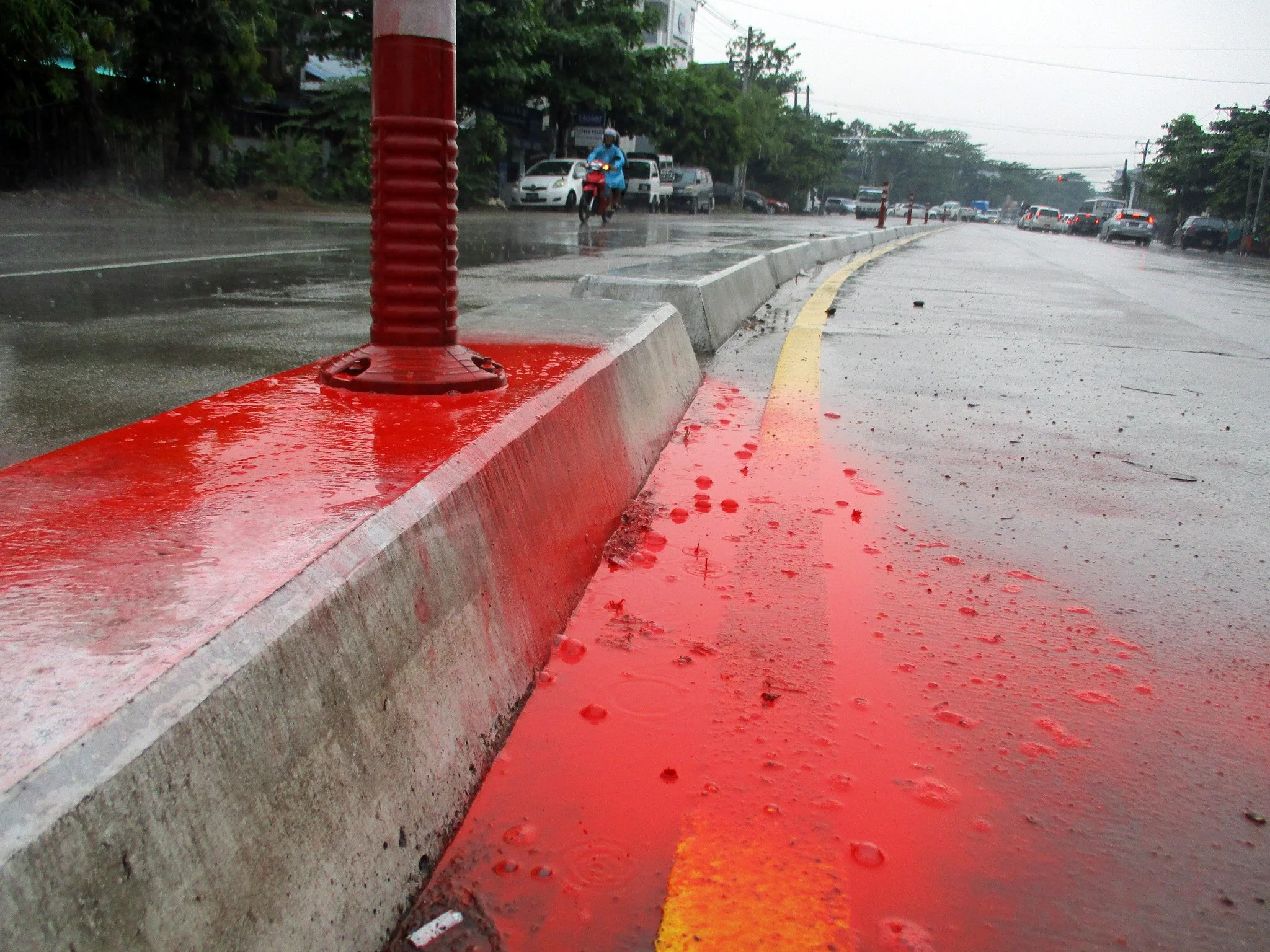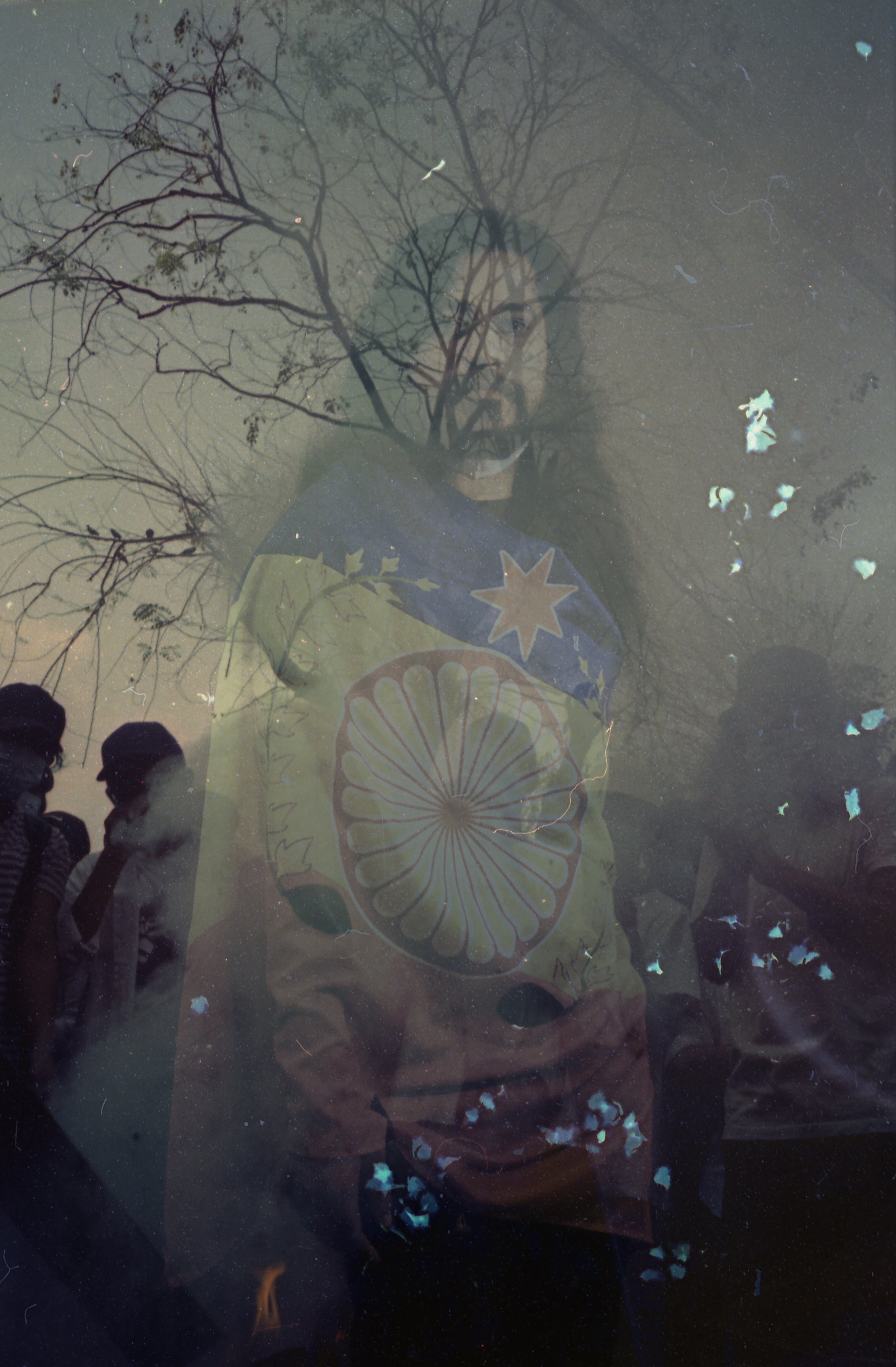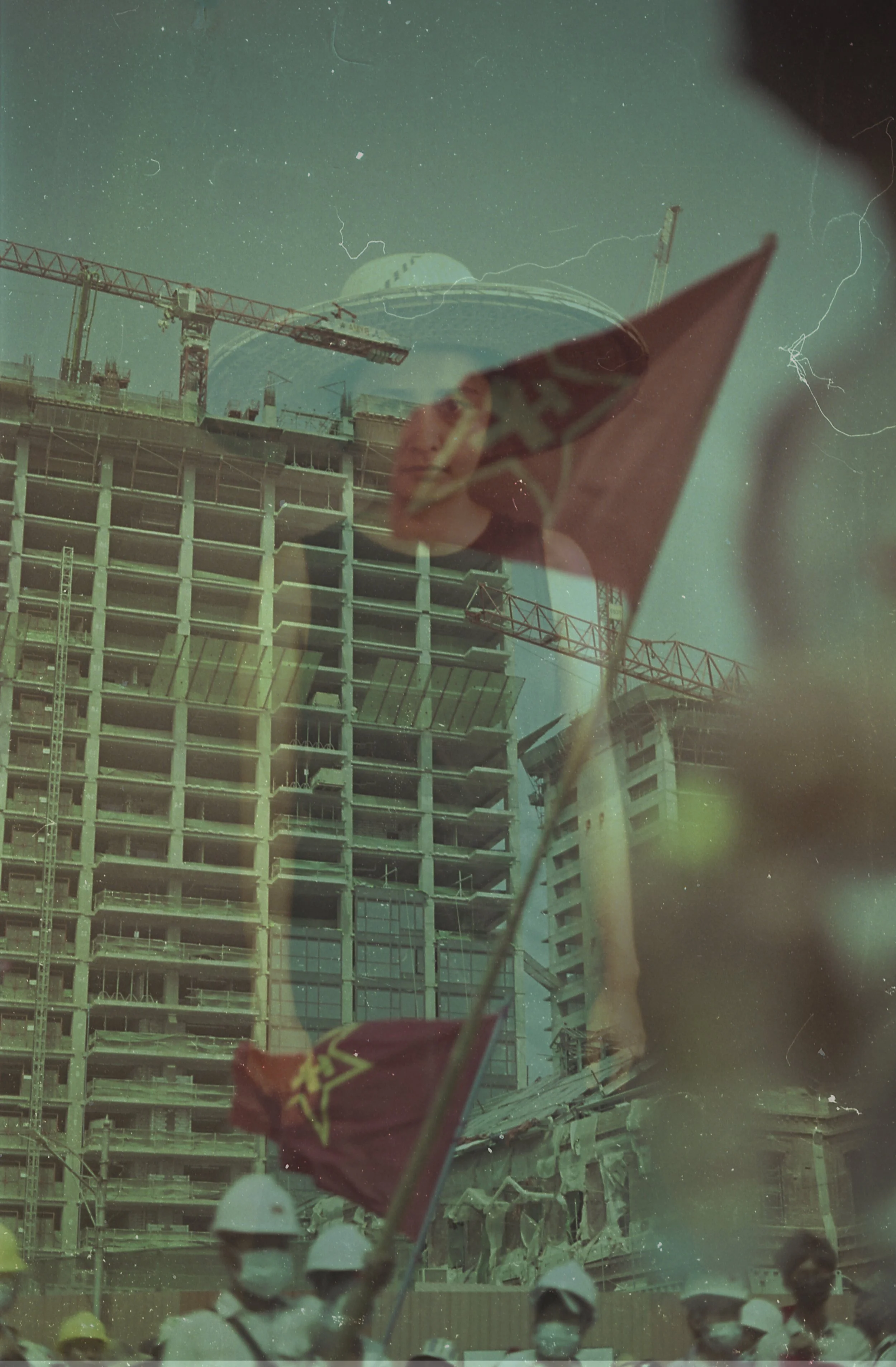Education Resources for Teachers and Students
Download the full education kit here
Richie Nath, Maya and the Burning Village 2017
inkjet print on matte poster paper, 93 x 56.5 cm
Fighting Fear II: It Goes Without Saying
The voice in the crowd and the role of contemporary art in speaking for social justice
These resources are designed for students in Years 11 and 12 studying Visual Arts through either the NSW Preliminary and HSC or IB syllabuses. They may also be useful for tertiary students from different disciplines visiting the exhibition. They aim to provide interesting entry points through which teachers and students can engage with works in the exhibition, and suggestions for more in-depth case studies.
The five artists selected for particular focus demonstrate the place and power of art in diplomacy and social critique. They employ media ranging from painting, photography, and performance art to drawing, revealing aspects of their personal, social, cultural and political worlds. Questions and activities invite students to engage with the material and conceptual practice of the artists, to consider the themes that emerge from the exhibition’s curation, and to make significant connections with their wider study of contemporary art.
Scroll down for suggestions and activities for teachers and students.
An Introduction to the Exhibition
Fighting Fear II: It Goes Without Saying is the follow-up to 16albermarle’s May 2021 exhibition Fighting Fear: #whatshappeninginmyanmar, in which 11 artists from Myanmar made work responding to the military coup of 1 February 2021, which deposed the elected government, instituted military rule and deprived the people of democracy and freedom.
Coinciding with the second anniversary of the military coup, Fighting Fear II: It Goes Without Saying revisits the ongoing struggle of the people in Myanmar, showcasing the varied responses of artists to developments and the current situations in Myanmar now. The exhibition examines more deeply what fear means in post-coup Myanmar and how people live with it. The revolution has changed and censorship has returned. But those artists still living in the country – whether in Yangon or safer areas – are finding new ways to work and exist despite the terrible day to day reality of living under a military regime. While many horrific events have ceased to be reported on international media, life continues in cities, towns and villages across Myanmar.
The exhibition also explores the experiences of artists who fled the country for their own safety. They now face new and daunting circumstances living as refugees and immigrants, far from home and their families and having to cope with feelings of powerlessness about events in Myanmar.
Curatorial Statement
The conceptual premise of Fighting Fear II: It Goes Without Saying communicates the power in artists’ works reflecting shifts in society. With their fingers on the pulse of culture and media, artists are the image-makers of a revolution. Fighting Fear II: It Goes Without Saying welcomes back artists from the first exhibition in 2021 and introduces new voices to the stage. The artists’ lives have changed fundamentally since the coup. Some have left Myanmar and others remain, but all fear for the safety of family and friends. Yet they continue to engage. The only artists in Myanmar who have given up their craft are those that have joined the armed resistance. All others continue to organise and join exhibitions, share on social media and create in their home studios. Now we know there are more battles to be fought. Fighting Fear II: It Goes Without Saying recognises artists who continue to find new avenues of survival, struggle, and resistance through their work. From their perspective, it goes without saying that they must continue to speak out against the military coup. Intricately laced within the exhibition are feelings of guilt, fatigue, anger, resentment, and despair. As an audience, we must consider the feelings of futility that come with a life of activism and the seeking of social justice. If those of us in the international community are feeling frustrated with the slow-paced movement of the resistance, imagine those fighting, imprisoned and exiled. It takes courage to move forward in the face of danger and these artists are doing just that, wherever they now call home in the world.
Emily Phyo, #response365 #365 2022
inkjet print on Ilford Galerie Smooth Pearl photo paper, 43 x 43 cm
For Teachers
Fighting Fear II: It Goes Without Saying presents exciting opportunities to integrate new works by Burmese artists into existing curricula and case study investigations. The exhibition revisits the impact of the military coup d’état in February 2021 and readdresses the critical relationship between art, culture, democracy and social justice. This resource presents information, questions and suggested activities in relation to the exhibition as a whole and in more detail to five of the nine artists. They can be accessed before, during or after a visit to the gallery. They may also be used by teachers and students who are not able to visit the gallery in person.
This resource is linked to syllabus content and outcomes from the NSW Preliminary and HSC and the IB Diploma. It may also be helpful for tertiary students and teachers who might engage in more in-depth discussions in or beyond the gallery. Fine Arts and Art Theory undergraduate students and postgraduate students in Curating Masters programs may enjoy discussing the focus questions, which range in degree of difficulty and sophistication.
Questions and activities can be easily adapted to the specific needs of students and teachers in their individual contexts. The questions provided in this resource may be used for written responses, examination preparation, or for open-ended discussions in the gallery or the classroom.
Suggestions for Teaching and Learning
Students investigate the presence of artistic voice and activism throughout world history, beginning with works such as Picasso’s 1937 Guernica and Massacre in Korea (1951), and politically critical works by Jacques-Louis David and Francisco Goya.
To explore the evolution of art as a tool for cultural, political or generational voice, students reflect on exhibitions such as ‘Guerrilla Girls Review Of The Whitney’ at the American Art Biennal in 1987, Ai Wei Wei’s series S.A.C.R.E.D (as part of his larger ‘Disposition’ exhibition) at the 2013 Venice Biennale and the opening of the 105 mural public open-air gallery on The Berlin Wall in 1990.
Within their own national context, students are encouraged to examine Australian artists whose practice encompass calls to action for social justice, for example Tony Albert’s Hunter (2007) and Sorry (2008) or works presented by Jason Wing and Blak Douglas in the ‘Resist Stance’ exhibition at the Grafton Regional Gallery (2022).
Using tools such as The Guardian article A brief history of protest art from the 1940s until now-in pictures and the Google Arts & Culture A Visual Voice, students consider the power and impact of artworks which create a communal voice for the oppressed, censored or silenced by social or political circumstances.
They might look comparatively at works by artists such as Theodore Géricault, Honoré Daumier, Diego Rivera, Norman Rockwell, Barbara Kruger, Jenny Holzer, Johnson Jones, Blak Douglas, Vivik Vilasini, Shirin Nashat, He Jianping, Jason Wing, Tony Albert, Blak Douglas, William Kentridge, Yongsun Suh, Keith Haring, Tiana Bruguera, Banksy, JR, Shepard Fairey.
Finally, students select one artist from It Goes Without Saying and examine their practice in detail.
NSW HSC Syllabus Focus: Art Criticism/Art History
Artists’ Practice, Conceptual Framework (Artist/Artwork/World/Audience)
International Baccalaureate Diploma Syllabus Focus: Visual Arts in Context
Theoretical Practice: Students examine and compare the work of artists from different cultural contexts.
Curatorial Practice: Students develop an informed response to work and exhibitions they have seen and experienced.
Questions for discussion could include:
What is artistic activism?
Why do/should artists risk their personal safety to create a communal voice?
How can art influence the community outside the art world?
What benefits or complications can social media and the digital world have on contemporary artistic activism?
How important is form in art of social critique?
Does art have a role in politics and democracy?
Does art need to be accessible to everyone if it is also activist?
Questions Inviting Written Responses:
How do contemporary artists communicate ideas about cultural, political or generational voice through their art?
Art is not merely a mirror that reflects society, but a hammer with which to shape it; a powerful tool that can transform the way we see the world.
Discuss this statement with reference to specific artists and artworks from It Goes Without Saying.
Examine two artists from It Goes Without Saying that create new meaning through the use of symbolism and/or postmodern techniques.
Analyse how a place’s past and present can be explored through visual arts. Make reference to two artists from It Goes Without Saying.
Useful Links:
https://artsandculture.google.com/usergallery/4wIS_KctpRdHLA
https://medium.com/@marinetanguy/the-voice-of-a-generation-art-millennials-da2d4adcfef1
https://www.artic.edu/highlights/28/art-activism
Familiarise yourself with this vocabulary list:
Art activism: a dynamic practice combining the creative power of the arts to move us emotionally with the strategic planning of activism necessary to bring about social change.
Dissidents: a person who opposes official policy, especially that of an authoritarian state.
Social justice: justice in terms of the distribution of wealth, opportunities, and privileges within a society.
Marginalise: to treat (a person, group, or concept) as insignificant or peripheral.
Oppression: prolonged cruel or unjust treatment or exercise of authority.
Communal voice: Communal voice: the group operates as commentator on the action while speaking from the same perspective, or individuals speak the words of many.
Call to action: an exhortation or stimulus to do something in order to achieve an aim or deal with a problem.
Propaganda: information, especially of a biased or misleading nature, used to promote a political cause or point of view.
Censorship: the suppression or prohibition of any parts of books, films, news, art, etc. that are considered obscene, politically unacceptable, or a threat to security.
For Students
Here you will find brief information and some focus questions about 5 artists from It Goes Without Saying. You can deep dive into researching individual artists, or compare and contrast their work with others, considering how they communicate ideas about Myanmar’s history and a post-coup life.
About contemporary art
in southeast Asia
Eluding simple definitions or falsely universalising connections between distinct histories and cultures, the art of southeast Asia is vibrant, dynamic and complex, bearing traces of “the rise and fall of kingdoms and empires, and … the historical traces of colonisation and the often-traumatic birth of nations.”1 Artists from Indonesia, Cambodia, Thailand, Myanmar, Laos, the Philippines, Vietnam, Singapore and Malaysia explore local and global themes including personal and national identity and community, cultural knowledge, power, faith and the increasingly urgent impact of humans on fragile ecosystems.
Find out more
https://theartling.com/en/artzine/artist-defined-contemporary-southeast-asian-art
https://www.sothebys.com/en/articles/five-of-the-most-influential-women-artists-from-southeast-asia
https://artradarjournal.com/7-influential-women-artists-from-asia-pacific/
Joan Kee (2011) Introduction Contemporary Southeast Asian Art, Third Text, 25:4, 371-381, DOI: 10.1080/09528822.2011.587681 at https://www.tandfonline.com/doi/pdf/10.1080/09528822.2011.587681
1 “No Country: Contemporary Art for South and Southeast Asia”, Solomon R. Guggenheim Museum and Foundation
Min Ma Naing, Faces of Change: Businesswoman, 32 2021
Other Education Resources:









